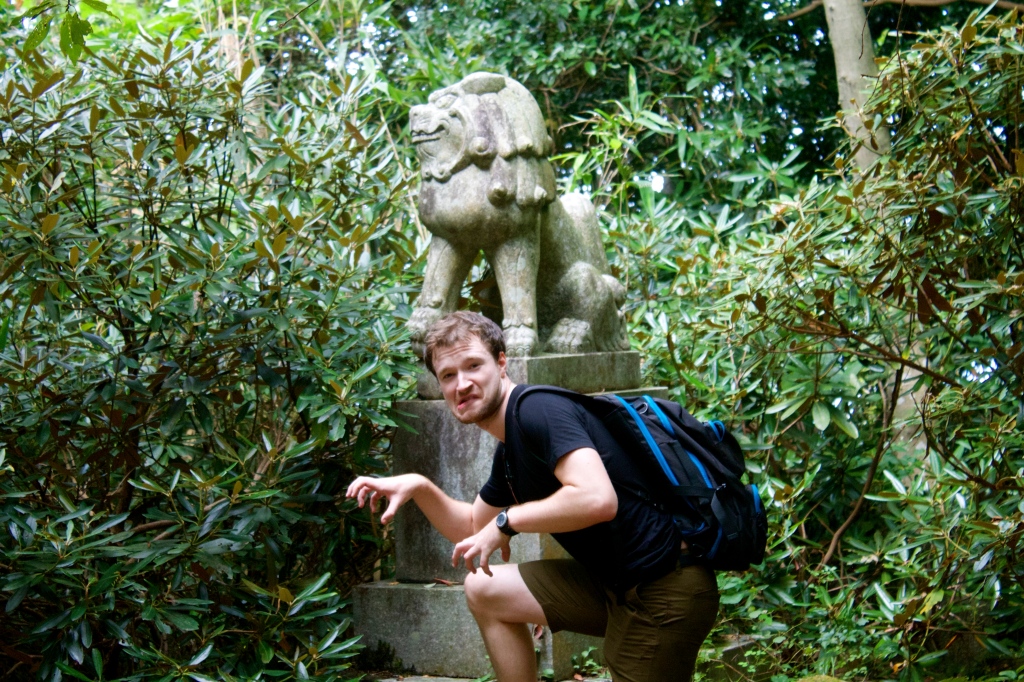After a frenetic first week of lessons, teaching and sorting out our Gaijin (foreigner) cards, Graham, Joseph and I decided to cut loose from the Fukuoka cityscape and went for a hike. A student of mine, Yoshi, had recommended climbing Mt Homan (892m), locally referred to as Homan-zan, located on the outskirts of Fukuoka in Dazaifu city. A short train ride on the Nishitetsu line took us to Dazaifu station where we were confronted by the awesome Dazaifu Tenmangu shrine. Unabated in our mission by this spectacle and in the knowledge that the Homan-zan hike doubles as a pilgrimage route between the twin Kamado shrines, we continued on through the city to the trailhead and each took mental notes to come back and explore this beautiful part of Fukuoka at a later date.
While a bus from Dazaifu station could have saved us the legwork to the base of the mountain, the clear blue of the sky and cool early morning temperatures made the walk a pleasant warm-up to the hike ahead and the views of the summit in the distance gave some perspective on what lay ahead. With distance from Dazaifu, the landscape rapidly changed from urban jungle to rice paddies to the impenetrably dense looking forests and bamboo groves that marked the beginning of our ascent. As we walked, we were treated with our first sighting of Japanese wildlife in the form of a praying mantis elegantly straddling a roadside railing and a lost-looking crab, who was clearly having a crab day so far from the sea.






A tōre gate marked the trailhead and the start of the pilgrimage route between the two Kamado shrines. The shrines, we later found out, are dedicated to those looking for love, so for any Hobbit fans hoping to find the Lonely Mountain, this is your best bet. Behind the tori gate lay the first of the many steps leading to the summit, running through a corridor cut out of the earth. As we began our climb, it rapidly became apparent that the estimated hiking time of 4-5 hours would be dashed by Graham, who mountain-goated up the steps at a blisteringly fast pace, dragging me and Joseph in his wake gasping for what little breath we could find in the humid midday air. Bamboo groves and fantastically tall native forest (suba) lined the trail and the sound of trickling water betrayed the recent stormy weather, providing a more soothing soundtrack then our own ragged breath as we continued up, up, up. Ornate, man-made statuettes (lions, lantern posts and shrines) gave the trail further character and, as we approached the summit, the tinkling of bells carried by more reverent travellers added to the atmosphere. A detour from the main track, which is part of the longer Kyushu Nature trail, took us toward Homan-zan’s summit, where the steepest steps were saved for last. Jelly-legged, we summited about an hour and a half after reaching the trailhead.
The views from the top were stunning. In all directions, the mountains of northern-Kyushu lay before us, dramatically contrasting with the flat urban expanses which they contained. Though the haziness of the afternoon prevented us seeing south to Aso-san (Kyushu’s highest peak/extremely active volcano) we were delighted by the views over Fukuoka which showed the city’s great urban mass, extending from the northern sea south past the mountain on which we stood.
After spending some time absorbing the panorama before us and some vital refuelling, we started our descent. A steep staircase cut out of the rock took us in a different direction from which we had come, and circled us round through the Homan-zan camp site. Our guide sheet talked of an alternate descent to the steps that had carried us up the mountain, one that was less well trodden. One U-turn and some pidgin Japanese later, we were adopted by a kind Japanese gentleman (shouting to his friend in Japanese: I’ve found some Gaijin [foreigners], go on without me) who showed us to this new route and proceeded to guide us the whole way down, telling us of the local plants, the purpose of the pilgrimage between the two shrines and laughing at length at our suggestion of going to a Tofu restaurant for Steph’s Birthday. This route down provided a lovely contrast to the steps of our ascent, taking a more naturally contoured path down to the base. As we got lower, the sound of Cicadas, warmed by the now afternoon sun burst into life and mingled with the steady trickle of the streams that lined the path.
The path lead almost directly to the Kamado shrine at the base, which we had decided to skip earlier in the day in favour of a return visit. The shrine itself was beautiful, though felt Disneyfied by the shrine shop which offered both offerings and souvenirs. We observed the rituals of the legions of (mostly young) Japanese men and women praying and giving offerings at the Shrine before heading back to Dazaifu to complete our journey home.
Leave a comment